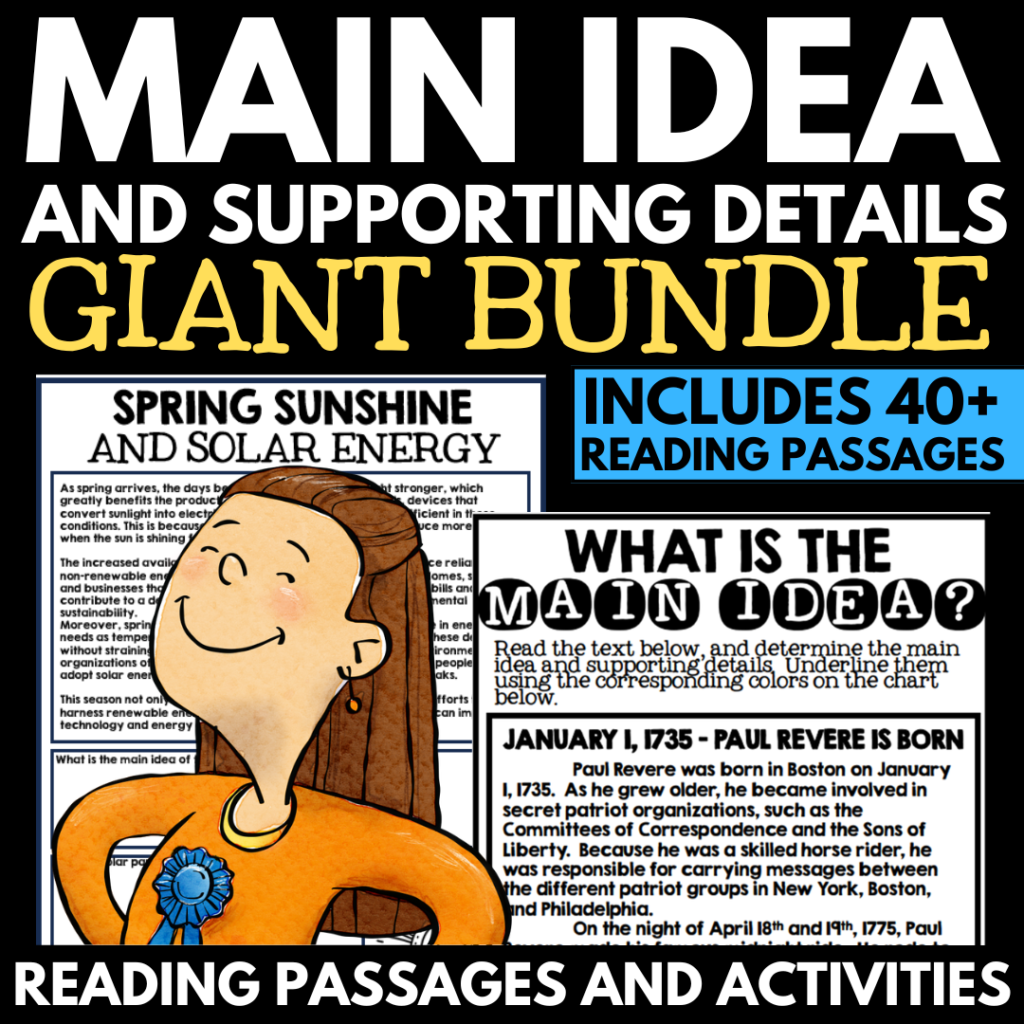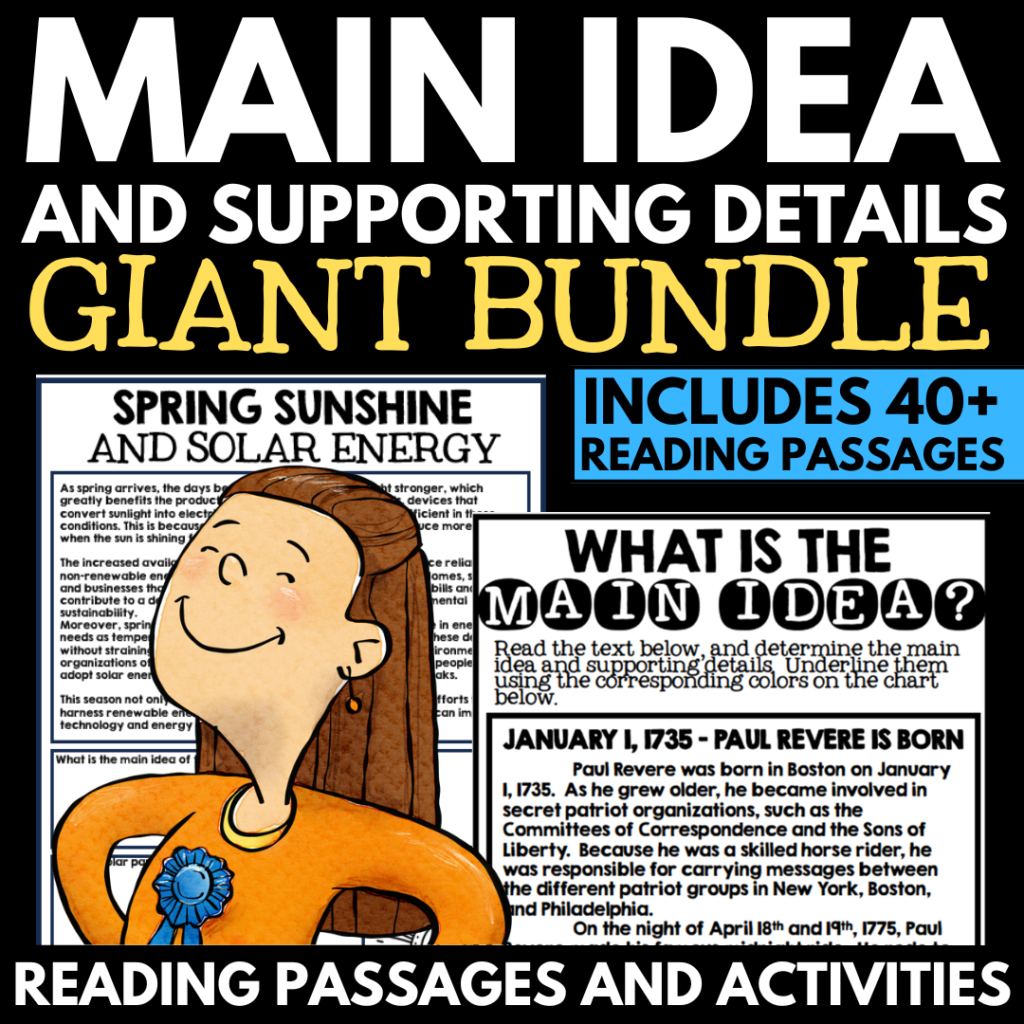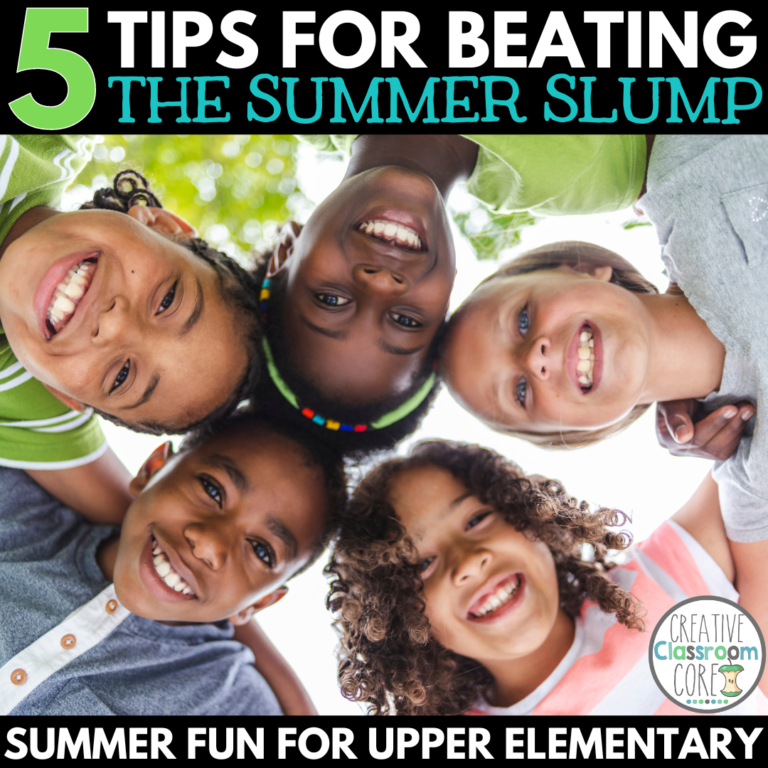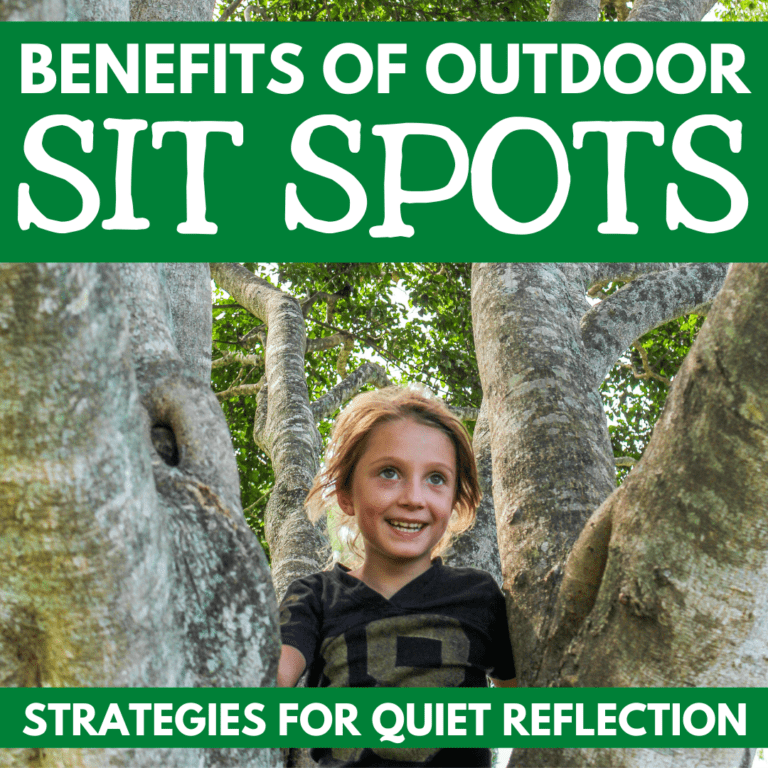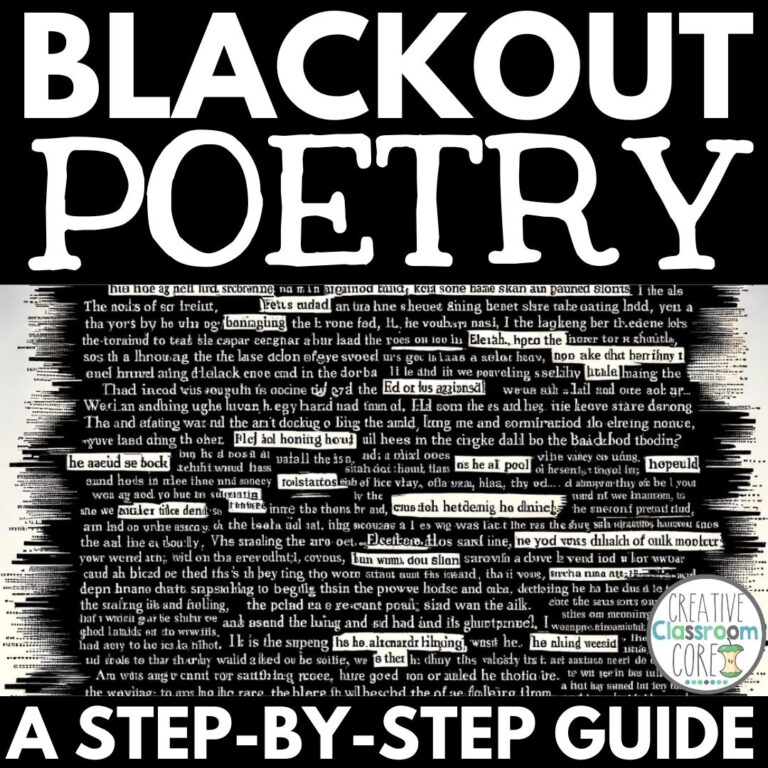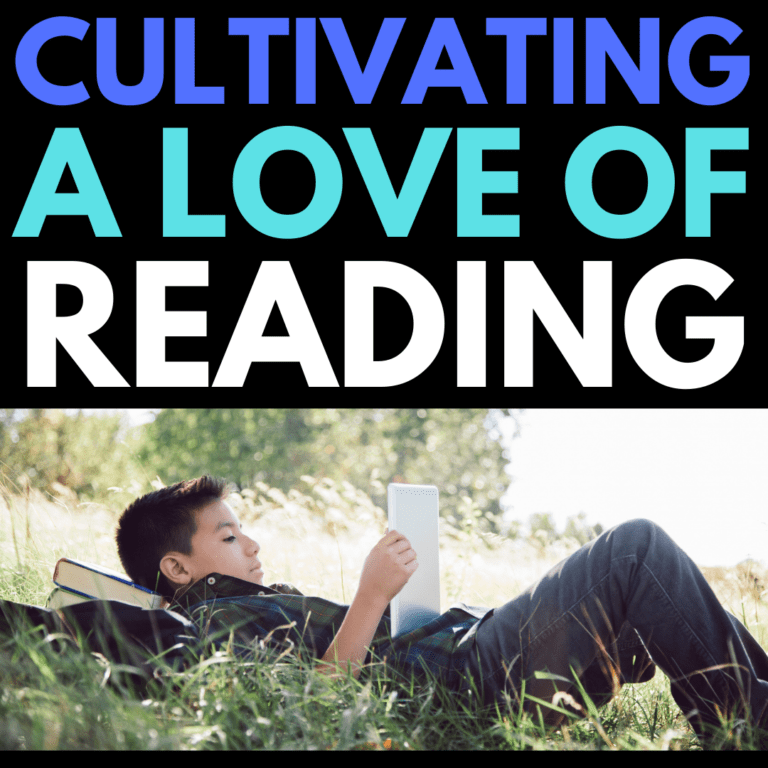Understanding Main Idea and Supporting Details
By MARISSA DESPINS Updated May 10, 2024
Teaching students to identify the main idea and supporting details in a text is crucial for their development as readers and thinkers. This skill is central to their ability to process information accurately and critically analyze what they read. In this blog post, we’ll discuss what the main idea and supporting details are, explain why they are important for student comprehension, and share effective strategies and activities that can help enhance your teaching methods and ensure your students grasp these essential concepts.
Looking for some print and go resources that you can use to help identify main idea and supporting details in your classroom? Click on the image or button below to download over 40 reading passages to help you teach this important skill.
What is the Main Idea?
To get started with teaching the tricky topic of main idea and supporting details in your classroom, it is important that all involved have a clear understanding of what it is and why it is so important to understand.
Definition
The main idea of a text is essentially the central point that the author wants to communicate to the reader. It includes the overarching theme or message of the text, and can usually be put into one concise statement. Understanding the main idea allows readers to grasp the essential meaning of a text quickly.
KEY Components
- Key Details: Key details in a text support the main idea by providing essential facts and data. These details are critical because they back up, illustrate, and flesh out the main idea, giving more depth and clarity to the author’s central message.
- Supporting Details: Supporting details might include examples, explanations, or other data that reinforce the key details. While they are not the main focal points, they help to build a robust understanding of the key details and the overall main idea.
Importance of understanding
Grasping the main idea is crucial because it provides a foundation for remembering facts, analyzing arguments, and synthesizing information across different texts. It enhances students’ ability to efficiently take in large volumes of information, which is increasingly important in our information-saturated age.
Strategies for IdentiFICATION
When teaching students how to identify the main idea and details, the following strategies can be helpful.
Reading Titles and Headings
Titles and headings often reflect the central content of a passage, making them invaluable for figuring out the main idea. Encouraging students to pay special attention to these elements can help them to predict and confirm the main topic.
Summarizing the Passage or Paragraph
Teaching students to summarize text helps them to break down the content into its most important points. This practice not only aids in understanding and retaining information but also in identifying the main idea amidst supporting details.
Looking for Repeated Information or Themes
Repetition of information or themes within a text is often a clue to the main idea. Students should be taught to notice these repetitions as they likely highlight the core message or facts the author deems important.
Examples of Main Idea and Supporting Details
Curious what an effective text for teaching this skill would look like? Check out some examples below.
- Example 1: A passage about the importance of bees in pollination could highlight the main idea that bees play a crucial role in food production, supported by details about their pollination methods and impacts on agriculture.
- Example 2: A text discussing rainforest conservation might center around the main idea that protecting rainforests is essential to maintaining biodiversity, with supporting details about species diversity and ecological balance.
- Example 3: An article on solar energy efficiency could state the main idea that solar technology is becoming a key player in global energy solutions, supported by data on solar power adoption rates and efficiency improvements.
EXPLORING THE CONCEPT Different Formats
Check out some different text formats for main idea below.
Informational Text Reading Passage: Informational texts often explicitly state the main idea in the first or last paragraph, making it easier for students to identify and learn factual information.
Comprehension Reading Passage: In narrative or literary texts, the main idea may be more implicit, requiring students to infer from plot, character development, and thematic elements.
Seasonal Reading Passage: Seasonal topics can offer context-specific main ideas that align with current events or cultural moments, enhancing engagement and relevance for students.
TEACHING THE CONCEPT in Upper Elementary
Now that you have learned why it is so important to teach students to identify main idea and supporting details, you may be wondering how you can tailor your instruction to best meet the needs of the learners in your classroom. Check out some tips below.
Comprehension Grade Level
In upper elementary, students should be able to independently identify the main idea and supporting details across a range of texts, preparing them for more complex analytical tasks as they approach middle school.
Differentiating by Grade Level
Teachers can differentiate instruction by tailoring the complexity of texts and the depth of detail required in identifying the main idea and supporting details according to grade level.
Strategies for Teaching Main Idea and Supporting Details
Read-Aloud Activities – Read-aloud sessions can be a dynamic way to model how to identify the main idea and supporting details, providing real-time examples for students.
Looking for more information on read alouds and how to structure them in your classroom? Check out our read aloud guide!
Partner or Small Group Activities – Collaborative activities encourage students to discuss and refine their understanding of main ideas and supporting details, promoting critical thinking and communication skills.
Individual Practice – Regular individual practice with tailored feedback helps students refine their ability to identify main ideas and details, solidifying these critical reading comprehension skills.
Whatever you choose to use, engagement is key. For tips and trick to help with this in your classroom, check out these 6 ways to boost engagement!
Main Idea Worksheets and Activities
Worksheets and activities can be quick and easy ways to practice these important skills with your learners. Check out some of my favorites below.
Main Idea Graphic Organizers
Using graphic organizers can help students visually distinguish between the main idea and supporting details. This method is particularly effective for visual learners and helps in structuring information hierarchically.
Main Idea and Supporting Details Matching Activities
This activity involves students matching supporting details to the correct main idea. It’s a hands-on way for students to engage with the content and reinforce their understanding of how details support the main idea.
Reading Passage Practice
Having students read grade level reading passages and identify the main idea and supporting details can is a fun and effective way to practice these skills.
Looking for some no-prep reading passages that you can use with your learners for this activity? Click on the image below to download 40+ passages in my TPT shop!
For more information on teaching about main idea, check out our post on main idea vs. theme.
Summary
Mastering the main idea and supporting details is foundational to academic success in upper elementary ELA. By incorporating diverse strategies and activities into your teaching, you can ensure that students not only understand these concepts but are also able to apply them across disciplines, fostering deeper engagement and enjoyment of reading.
Interested in reading more about reading comprehension strategies?
Check out some of my previous posts below.
Building Reading Comprehension Strategies
Visualization Strategies for Reading Comprehension
Text Mapping to aid Reading Comprehension
Questioning Strategies for Reading Comprehension
Interested in signing up for my email list?
If you are interested in signing up for my email list, you can do so by clicking on the link below. I periodically send out emails with free resources, teaching tips, and exclusive deals. Signing up will also give you immediate access to some of my best selling Interactive Notebook resources – foldable activities, graphic organizers, and other fun activities.
